If you are looking to spruce up your home with a bit of tropical exoticness, then the addition of a Ponytail palm (Beaucarnea recurvata) is the plant for you. Although not really a palm despite its name and really a succulent, it makes a hardy and low-maintenance addition to any indoor setting. Below is a quick summary of their care.
How Do You Care For A Ponytail Palm Indoors: Grow your Ponytail palm in well-drained soil and water when the top 3 or 4 inches of soil become dry. Spray weekly to create humidity, fertilize monthly, keep indoor temperatures around 60°F to 85°F and situate in bright light.
Continue reading for all the tips and details of their care to keep your Ponytail palm healthy and thriving for years to come.
How Do You Care For A Ponytail Palm Indoors?
Ponytail palms belong in the Asparagaceae family, which is the same family as agaves. This tree-sized succulent gets its common name from its long, flowing leaves that drape down over the trunk giving it a “ponytail” effect.
In addition, its tall woody trunk gives it the appearance of being a variety of palm and in many ways, it has the same growing requirements as many palm trees. Because of the plant’s unusual shaped base, it also goes by the common name “Elephant’s Foot Plant.”
Its native range includes the semi-desert regions of Guatemala, Belize and southeastern Mexico, where there are 350 year-old specimens registered, so it is a long-lived plant when given proper care. This includes its life as a houseplant.
Not tolerant to freezing temperatures, only those living in consistently warm locales can grow a Ponytail palm outdoors. However, those living in cooler climates can grow the succulent to grace their indoor spaces as it tolerates life as a houseplant quite well.
In fact, the Ponytail palm has become very popular grown as an indoor and outdoor ornamental throughout Europe and the world. In addition, The Royal Horticultural Society awarded the Ponytail palm its Award of Garden Merit.
In Europe, the Ponytail palm scientific name is most commonly referred to as Nolena recruvata, but it is the same plant as Beaucarnea recruvata.
When grown outdoors within its hardiness range, Ponytail palms can grow as tall as 30 feet. However, when grown indoors as a houseplant it typically reaches a mature height of around 6 to 8 feet tall.
Its noteworthy characteristics include its large and swollen base, also called a caudex that gives way to its trunk-like stem topped with flat, palm-like leaves with serrated edges that can grow 1.5 to 5 feet in length.
It has a slow rate of growth, so expect it to take quite a few years before it reaches its maximum height grown indoors or outside.
These low-maintenance plants are not fussy when given proper care and growing conditions. This makes them suitable houseplants for the beginner or those who feel they have a black thumb. Ponytail palms are sure to bring eye-catching interest wherever they are used inside your home.
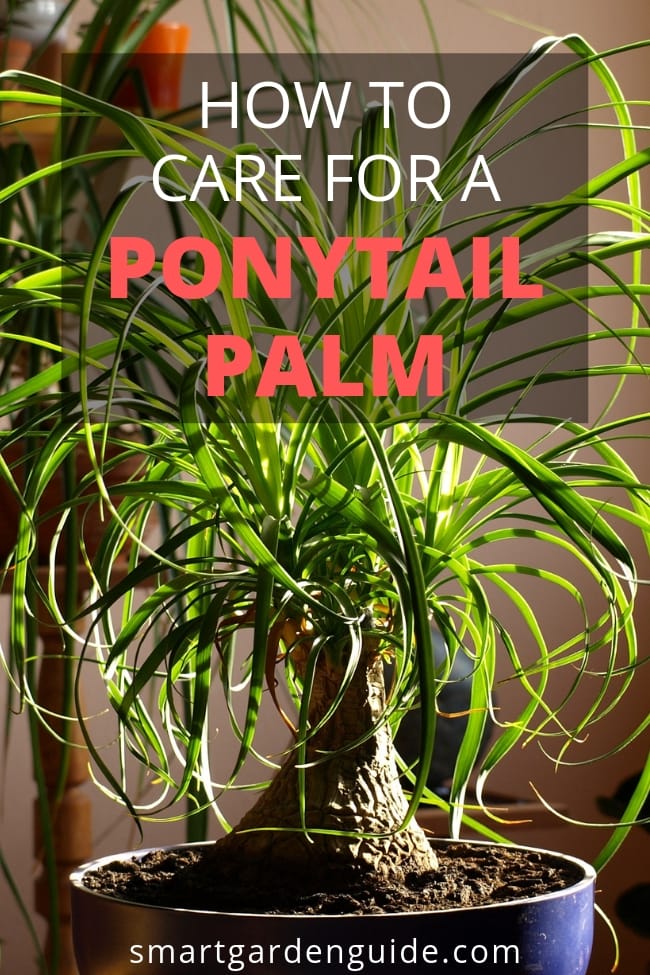
Soil Conditions For Ponytail Palms
When it comes to proper soil to use for your Ponytail palm, just make sure it is fast draining, otherwise, you will end up with rot problems. Ponytail palms will not thrive in heavy soils that have a tendency to retain water and remain soggy and in fact, you can end up killing it if it remains in saturated conditions for too long.
Commercial potting mixes that will work well are those used for growing cacti or succulents. Lightweight potting mixes also work well as they drain properly. However, use caution if using a straight potting soil because many times these mixture have a tendency to be too heavy and retain too much moisture.
You can also make your own soil mixtures as listed below:
- 1 part coarse sand, 1 part potting soil & 1 part perlite
- 1 part compost, 1 part potting mix
- 1 part coarse sand, 1 part compost & 1 part potting soil
Many types of potting mixes already have a slow-release fertilizer incorporated into the mix, which cuts down on the need for additional fertilization for up to three months. Whatever soil blend you choose to utilize, just make sure it drains well when water is applied.
Ponytail Palm Light Conditions
When grown outdoors, Ponytail palms grow best in a site located in full sun to partial shade. Indoor grown Ponytail palms should be placed in the brightest area of your home.
However, if they are forced to live in darker conditions for several months and provided they are receiving otherwise proper care, their growth will not skip a beat.
Once the weather warms in springtime and if you would like to give your Ponytail a break from living indoors, place it in a partially sunny location and not in direct sun. Although it might be used to a bright indoor spot, outdoors the effect of full sun might be a bit too much and the leaves may burn.
Indoor Temperature Requirements
As long as your indoor temperatures are not freezing during winter, your Ponytail palm will grow just fine. If it’s comfortable for you, it is comfortable for the Ponytail.
In addition, due to its native range being located in semi-desert conditions, the heat and dryness from a furnace will not bother it as long it’s not situated directly in front of a vent. Indoor temperatures ranging between 65°F and 80°F are suitable for good growth.
Since Ponytail palms are tropical plants not tolerating freezes or frosts, if you placed your Ponytail palm outdoors to give it a break from indoor growth, just remember to bring it back indoors before winter’s chill hits your location.
Water Requirements
The biggest mistake you can make when caring for your Ponytail palm is overwatering it or allowing it to remain in soggy conditions for too long. This is a sure way for rot to develop and you can lose your plant. In addition, this is another reason why growing it in a well-drained soil is imperative for good growth.
The plants have a high tolerance to drought conditions and are more forgiving of you forgetting to water than watering too much. Part of the job of their wide base, other than giving the plant a unique appearance is for storing water.
Ponytail palms do not require regular water as many houseplants do. In fact, it’s probably not necessary to water more than once every two weeks. Allow the soil to dry before applying more water. When you do water, water deeply and allow it to run out of the pot’s bottom drain holes. Once the soil has completely drained, you should empty the drip tray or cache pot.
The best types of water to use on your Ponytail include:
- Use room temperature water and not cold.
- Rainwater is suitable for use.
- Allow water from your faucet to sit out overnight before using.
During winter, Ponytail palms are dormant and not actively growing. Therefore, their requirements for water are even less than through the growing seasons of spring through summer. You probably will not have to water your plant but once every two to three weeks.
A good way to figure out if you need to water is by sticking your finger into the soil and if it feels dry three or four inches down, apply water.
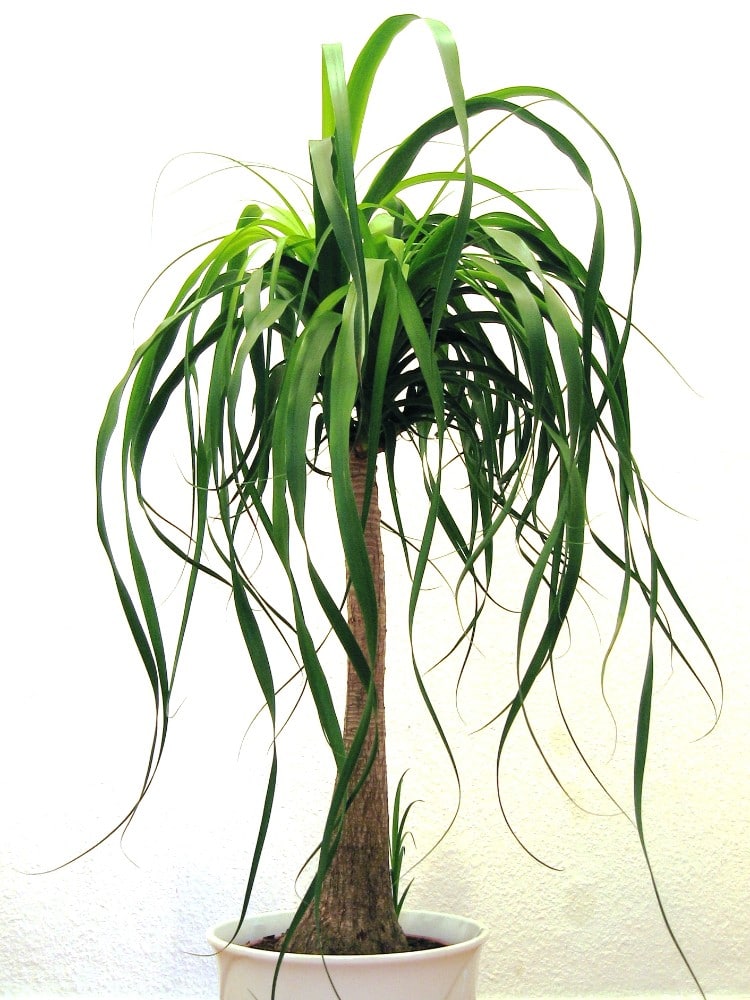
Ponytail Palm Humidity Requirements
The fact that Ponytail palms are native to arid climates means they are not as fussy about humidity as many tropical houseplants are. Although giving the foliage a nice spray of water each week will not hurt it and will help remove any dust particles making their home on the leaves.
Just fill your spray bottle up with rainwater or water that has been allowed to sit out overnight and give the foliage a good misting.
Fertilizer Needs
If you planted your Ponytail palm in a soil mixture that contained a slow-release fertilizer blend, then you don’t have to worry about additional feedings for about three months. Many slow-release fertilizers continue to breakdown in the soil feeding the plant for around two or three months.
However, if your soil doesn’t contain a fertilizer product, you will need to feed the Ponytail palm monthly while it is actively growing during spring through summer. Stop fertilizing while the plant is dormant in fall through winter.
- Use an all-purpose, water-soluble houseplant blend applied at half-strength monthly. This is the one I use and recommend (link to Amazon).
- Use a fertilizer specific for cacti or succulents applied at half-strength monthly.
- Use slow-release fertilizer granules applied per package directions concerning amounts and frequency of use, which is generally around every three months.
Ponytail palms are naturally slow-growers, so don’t think you can pump up the amount of fertilizer used to speed up growth. Applying too much product can result in the tips of the foliage burning.
Since the salts in fertilizers can buildup in the container’s soil over time, it’s best to flush the Ponytail’s soil every three or four months. Depending on the size of your plant, you can either do this job indoors or take it outside to the hose. Flushing salts from the soil is relatively basic:
- Allow a gentle stream of water to run through the soil for about five minutes, flushing out any salts. Then, let the container fully drain and empty out the catch basin if necessary and place the Ponytail back in the location where it was originally growing.
You don’t want to flush using a strong stream of water as you can dislodge the soil from around the root system, where it ends up in your sink, bathtub or on the ground outdoors.
Pruning Requirements
Pruning requirements for a Ponytail palm are very low. In fact, the only time you may need to get your pruning clips out for use on it is to snip off brown leaf tips or remove totally dead leaves.
The only other reason someone would prune a Ponytail is to snip off its top so it eventually sprouts out additional top sections. This results in anywhere from one to two additional tops, but is not necessary for good growth.
As when pruning any plant, always make sure your pruning tool’s blades are clean so you do not transfer any disease or pests to the Ponytail palm. This is as easy as wiping off the blades with rubbing alcohol.
The leaves have small serrations along the edges, so you might want to don a pair of gardening gloves when handling them so you don’t accidentally get cut.
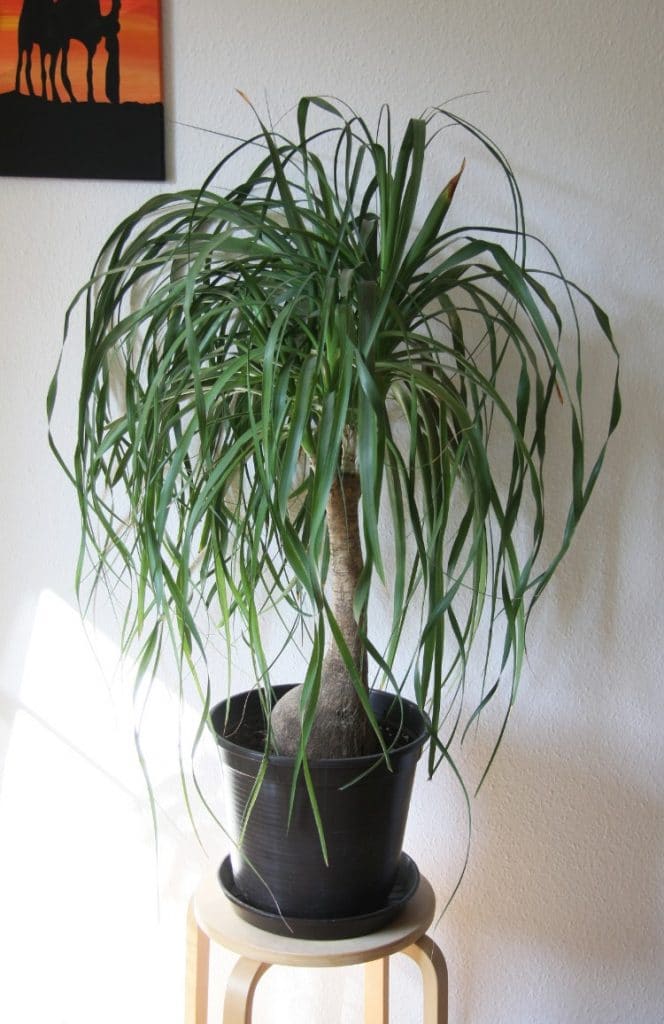
Potting Needs
Depending on how your newly purchased Ponytail palm is already growing in its nursery pot will be the judge on whether you need to repot it right away. There should be 1 two 2 inches of space from the bulbous caudex and the sides of the pot and no roots growing out of the bottom of the pot’s drain holes.
If the caudex is touching the sides of the pot or you see roots beginning to grow out of the pot’s bottom, you will need to repot before situating it in its indoor location. In addition, if you purchased a taller Ponytail palm and it seems like it is going to be top heavy, you probably will want to plant in a bigger and more stable pot to keep it upright and not fall over.
However, due to the Ponytail’s slow rate of growth, you probably won’t have to repot again for several years. You can maintain a smaller size plant by keeping it in smaller containers, provided the Ponytail doesn’t become root bound, and create a larger growing plant by planting in a larger container.
The only drawback from planting in larger containers is you have a greater chance of overwatering and keeping the soil too moist, especially if you are a constant waterer. If a larger pot is the way you want to go, just remember to only water after the soil has had a chance to dry out.
When it comes to the type of pot suitable for holding your Ponytail palm, any type of material works well for good growth. Containers made of plastic, wood or more porous materials like terracotta all are suitable provided they have bottom drainage. However, pots made from porous materials will have the soil drying out a bit quicker than those made of plastic, meaning you will have to water more frequently.
When deciding on the pot’s size, to prevent the chance of overwatering select one that is one to two sizes larger than the one the Ponytail is currently growing in. You want to have several inches of space from the edge of the pot to the caudex. Once again, feel free to use a larger container but just be sure to water correctly.
For those wanting to dress up the indoor location by using a decorative pot to hold the Ponytail palm, just be sure the inner pot the plant is growing in has bottom drain holes to prevent rot problems.
Most decorative containers have a solid bottom, which allows water to accumulate in its bottom. After you water the Ponytail, allow it to drain for about five minutes and then lift it out of the decorative pot and empty any water that drained into its bottom. See my article on growing plants in pots without holes for more info.
Potting your Ponytail palm is pretty basic and depending on its size, you may need the assistance of another person to help hold it while you replant in its new container.
- Fill a new draining container about a quarter to half of the way full with a well-drained potting mix. Apply water to the soil to help settle it.
- Place the Ponytail palm into the container’s center, being sure when you fill it with soil you are not planting any deeper than it was originally growing in its previous pot.
- Fill the remainder of the pot with soil, firming it around the Ponytail’s base using your fingers.
- Water again and until it runs from the bottom drain holes and situate back in its preferred growing location indoors.
Propagating Ponytail Palms
Although it is possible and not difficult to propagate new plants through planting seeds, indoor grown Ponytail palms do not bloom so seeds are never produced. However, if you are lucky enough to have seeds given to you, planting is basic.
- Fill a 4- to 6-inch container with bottom drainage with a well-drained potting mix. Water the soil to settle it.
- Plant the Ponytail palm seed at the same depth as its size. For example, if the seed is 1-inch in diameter, plant the seed 1 inch deep in the soil. Water the soil again.
- Place the container in a warm and sunny location and water when the top inch of soil becomes dry.
Next come patience as it can take anywhere from four weeks to three months or so for your seeds to germinate. Allow the Ponytail seedlings to remain in their pots until they are around four inches tall before repotting in something a bit larger. Since their growth is so slow, the Ponytail seedlings will happily reside in their starting pots for quite some time before you will need to repot.
Another way of propagating new plants is by removing offsets that can eventually develop around the mother Ponytail’s base. Once again, it may take quite some years for an indoor plant to produce babies, so don’t get discouraged if you don’t see any babies developing for quite a few years. However, if you do find the mother plant developing offsets, below is how to handle them for further propagation:
- Allow the offsets (babies) to develop to around 4 inches tall before you attempt to remove them from the mother Ponytail.
- Using a clean, sharp knife carefully cut the baby from where it is attached to the mother’s base, trying not to cut into the baby’s base and gathering as many roots as possible.
- Fill a 6-inch container with a well-drained potting mix and water to settle the soil.
- Dip the end of the Ponytail offset into rooting hormone and shake off any excess.
- Place the offset into the container and fill with soil, firming around the offset’s base. Be sure not to plant any deeper than it was originally growing by the mother Ponytail.
- Water again and place in a bright and warm location. Water again when the soil dries.
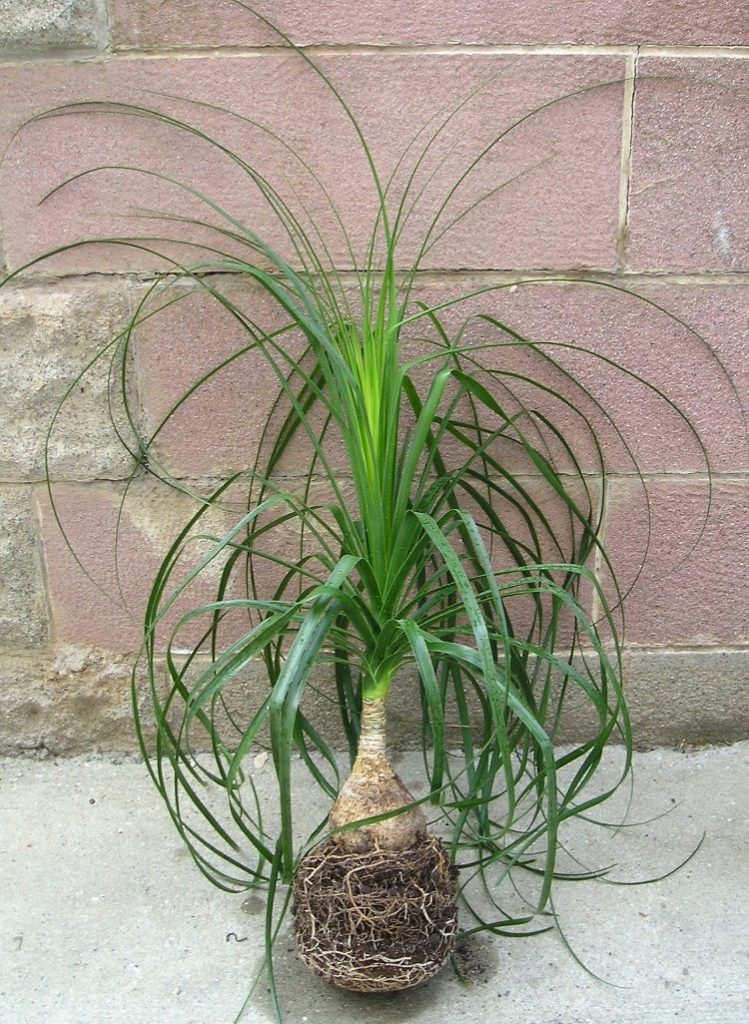
Ponytail Palm Disease Problems
Properly grown and cared for indoor Ponytail palms are relatively disease-free. The biggest problem is caused by rot due to the soil being too soggy. This is easily preventable by:
- Watering when the top 3 to 4 inches of soil becomes dry.
- Growing the Ponytail palm is a soil medium that is fast draining and not too heavy.
- Not growing the Ponytail palm in a container that is too large, as the soil will have a tendency to dry slower.
- Growing the Ponytail in a container that has bottom drainage.
One of the first signs of stem rot are the Ponytail palm’s leaves begin yellowing. If you notice this condition and feel you are overwatering, withholding watering will often stop the problem before it continues further, which leads to the death of the plant.
In severe cases of stem rot, the entire bulb (caudex) and stem becomes squishy and eventually collapses. Once this happens your only course of action is to discard the plant, as there is no cure.
Pest Problems
As with disease problems, indoor pests rarely bother Ponytail palms. However, spider mites, which are the bane to indoor gardeners everywhere, can sometime be problematic. It is easy to note if you have a spider mite problem because the tiny pests create a fine webbing that covers the Ponytail’s leaves. These pests suck the juices from the plant, so quick action is necessary especially to prevent them from invading your other indoor plants.
Spraying the top and undersides of all the leaves with an insecticidal soap or Neem usually does the trick. You may have to apply weekly until you no longer see the webbing or the mites. However, it is always best to follow the particular product’s label when it comes to amounts to use and frequency of use.
Why Are The Tips Of My Ponytail Palm Turning Brown?
If you start noticing the tips of your Ponytail palm’s leaves starting to brown, it can be one of two things. You are either not giving the plant enough water or you are apply too much fertilizer.
Although a Ponytail palm is more forgiving of under-watering than overwatering, it is best to water when the top three of four inches of soil feels dry. When you water, be sure to water deeply and until it runs from the bottom drain holes.
When it comes to fertilizing, it’s best to use a half-strength, water-soluble formula applied once per month. If the soil mixture you used to plant your Ponytail contains a slow-release blend, there’s no need to apply additional nutrients for about three months. Slow-release fertilizers continue to breakdown in the soil with each watering for about two to three months.
Can You Replant A Ponytail Palm?
Due to their slow growth, Ponytail palms only require repotting every two to three years. If the plant’s bulbous base is touching the sides of its current pot, it is time to repot into a container that is one to two sizes larger. Just make sure the container has bottom drain holes and use a well-drained soil.
How Do You Propagate A Ponytail Palm?
Although indoor grown Ponytail palms don’t flower and produce seeds, you can plant seeds in small containers that drain. Plant as deep as the seed’s size, water when the soil feels dry, and place the container is a warm and sunny location.
You can also plant pups, or offsets by cutting them of the mother plant, dipping the end in rooting hormone and planting the pup in a draining container as deep as it was originally growing. Water when the soil dries and place in a warm and sunny location.
Can You Trim A Ponytail Palm?
Ponytail palms have very low requirements for pruning. Although, you can trim off any dead or damaged leaves as they occur using clean pruning tools. It’s also possible to trim off the top of the Ponytail so it will eventually develop two to three tops.
Do Indoor Ponytail Palms Have Pests?
Although considered pest-free, indoor Ponytail palms can occasionally be plagued by spider mites. The pest rears its ugly head through covering the leaves with fine webbing and sucking out their juices. Before the pests transfer to your other indoor plants, spray the Ponytail’s leaves with an insecticidal soap or Neem oil.
Additional FAQs
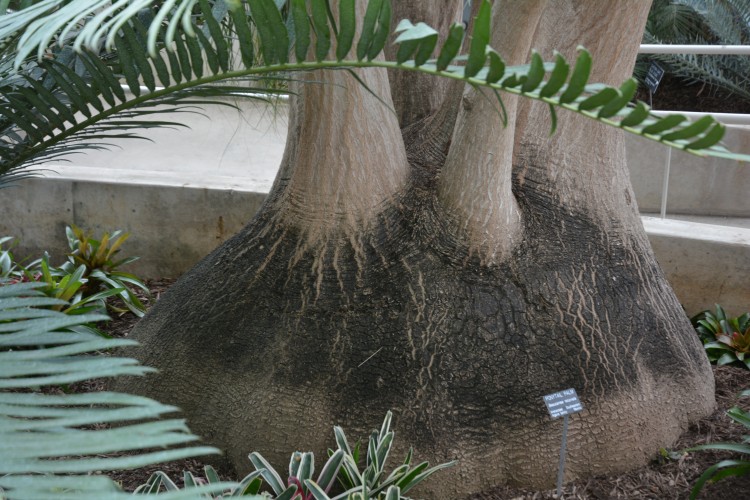
How Big Do Ponytail Palms Get?
When grown outdoors, Ponytail palms can grow 30 feet tall however, those grown indoors usually top out at 6 to 8 feet tall.
Are Ponytail Palms Toxic to Cats?
Ponytail palms aren’t toxic to people, cats, dogs or horses.
Do Ponytail Palms Flower?
When grown indoors, Ponytail palms do not flower, however, those grown outdoors produce clusters of creamy yellow flowers in spring through summer.
How To Grow Multiple Tops On A Ponytail Palm?
You can grow multiple tops on your Ponytail palm by trimming off the entire top, which then will sprout an additional two to three tops.
Many thanks for reading this guide to Ponytail Palm care. I hope your plant stays healthy and thrives for many years to come. Please have a look at the rest of my articles to learn loads more about caring for your houseplants.
Whether you’re just starting out, or just need some help with your houseplants, check out my resources section where I tell you about the best books, tools and resources that can help you to have more success in looking after your plants.


